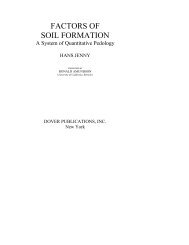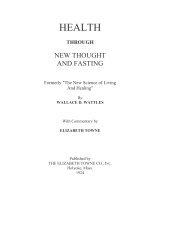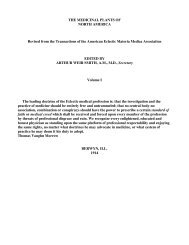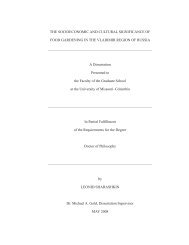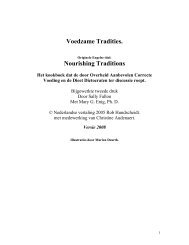historical and scientific perspectives on the health of canada's first ...
historical and scientific perspectives on the health of canada's first ...
historical and scientific perspectives on the health of canada's first ...
You also want an ePaper? Increase the reach of your titles
YUMPU automatically turns print PDFs into web optimized ePapers that Google loves.
Assembly <strong>of</strong> First Nati<strong>on</strong>s Nati<strong>on</strong>al Chief Phil F<strong>on</strong>taine affords a relatively recent summary <strong>of</strong><br />
<strong>the</strong> status <strong>of</strong> <strong>the</strong> <strong>health</strong> transfer process which has been occurring am<strong>on</strong>g <strong>first</strong> nati<strong>on</strong>s.<br />
Nearly half <strong>of</strong> First Nati<strong>on</strong> communities now c<strong>on</strong>trol <str<strong>on</strong>g>and</str<strong>on</strong>g> deliver <strong>the</strong>ir own <strong>health</strong><br />
services under <strong>the</strong> Federal Health Transfer Policy. There are successful<br />
community-based projects aimed at improving <strong>the</strong> integrati<strong>on</strong> <strong>of</strong> <strong>health</strong> services.<br />
Provinces such as Manitoba, Ontario, Alberta <str<strong>on</strong>g>and</str<strong>on</strong>g> New Brunswick are reaching<br />
out to include First Nati<strong>on</strong>s in establishing electr<strong>on</strong>ic <strong>health</strong> records <str<strong>on</strong>g>and</str<strong>on</strong>g> tele<strong>health</strong><br />
networks to provide timely access to patient informati<strong>on</strong> <str<strong>on</strong>g>and</str<strong>on</strong>g> care…During<br />
<strong>the</strong> historic Canada-Aboriginal Peoples Roundtable <strong>of</strong> April 19, 2004… I stated<br />
that our visi<strong>on</strong> for improved <strong>health</strong> revolves around a First Nati<strong>on</strong>s c<strong>on</strong>trolled<br />
<str<strong>on</strong>g>and</str<strong>on</strong>g> sustainable <strong>health</strong> system that builds effective capacity <str<strong>on</strong>g>and</str<strong>on</strong>g> asserts First<br />
Nati<strong>on</strong>s jurisdicti<strong>on</strong> in <strong>health</strong>, aligned with a holistic <str<strong>on</strong>g>and</str<strong>on</strong>g> culturally appropriate<br />
approach… The role <strong>of</strong> research in fur<strong>the</strong>r informing First Nati<strong>on</strong>s’ united efforts<br />
to improve <strong>the</strong> <strong>health</strong> <str<strong>on</strong>g>and</str<strong>on</strong>g> well-being <strong>of</strong> our peoples cannot be underestimated. 62<br />
1.10 INTERMINABLE ABORIGINAL COMMUNITY INFRASTRUCTURAL DEFICIENCIES<br />
Although throughout <strong>the</strong> 20 th century <strong>the</strong>re have been gradual socio-ec<strong>on</strong>omic improvements in<br />
virtually Aboriginal communities in Canada leading to improved living c<strong>on</strong>diti<strong>on</strong>s, at mid-point<br />
in <strong>the</strong> <strong>first</strong> decade <strong>of</strong> <strong>the</strong> 21 st century <strong>the</strong>re still remain significant infrastructural deficiencies in<br />
many Aboriginal communities. These deficiencies clearly c<strong>on</strong>tribute to c<strong>on</strong>tinuing unacceptable<br />
<strong>health</strong> levels. As <strong>of</strong> 2005, across Canada in First Nati<strong>on</strong> communities <strong>the</strong>re is a “housing shortage<br />
<strong>of</strong> between 20,000 <str<strong>on</strong>g>and</str<strong>on</strong>g> 35,000 units. The shortfall is growing by an estimated 2,200 units a year.”<br />
The limited supply <strong>of</strong> housing leads to “overcrowded c<strong>on</strong>diti<strong>on</strong>s… [that]<br />
affects <strong>the</strong> <strong>health</strong> <str<strong>on</strong>g>and</str<strong>on</strong>g> well-being <strong>of</strong> Aboriginal people living <strong>on</strong>-reserve.”<br />
New Federal commitments over <strong>the</strong> next five years, combined with<br />
Canada Mortgage <str<strong>on</strong>g>and</str<strong>on</strong>g> Housing Corporati<strong>on</strong> (CMHC) will fall short<br />
<strong>of</strong> even keeping up with <strong>the</strong> estimated new unit requirements. In<br />
Canada’s North, 16.8 percent <strong>of</strong> Inuit households were “overcrowded<br />
<str<strong>on</strong>g>and</str<strong>on</strong>g> in core housing need compared with 1.9 percent for n<strong>on</strong>-Aboriginal<br />
households. The Inuit populati<strong>on</strong>’s young average age <str<strong>on</strong>g>and</str<strong>on</strong>g> high birth<br />
rate mean numbers <strong>of</strong> families <str<strong>on</strong>g>and</str<strong>on</strong>g> households are growing rapidly,<br />
putting increasing pressure <strong>on</strong> <strong>the</strong> current housing stock.” 63<br />
The annual Report <strong>of</strong> <strong>the</strong> Commissi<strong>on</strong>er <strong>of</strong> <strong>the</strong> Envir<strong>on</strong>ment <str<strong>on</strong>g>and</str<strong>on</strong>g> Sustainable Development to<br />
Parliament (2005) found that when it comes to potable water, First Nati<strong>on</strong> communities do not<br />
have <strong>the</strong> same level <strong>of</strong> protecti<strong>on</strong> as does <strong>the</strong> rest <strong>of</strong> Canada. Federal assessments in 1995<br />
indicated that about 25% <strong>of</strong> all First Nati<strong>on</strong>s' water systems were at “high risk” to c<strong>on</strong>taminati<strong>on</strong><br />
<str<strong>on</strong>g>and</str<strong>on</strong>g> pose a “high risk” to human <strong>health</strong>. An more recent assessment in 2003 found that almost<br />
30% <strong>of</strong> systems were at high risk, indicating that <strong>the</strong> situati<strong>on</strong> is worsening. Currently, more than<br />
100 First Nati<strong>on</strong>s communities are under “boil water” advisories. The report notes that <strong>the</strong><br />
problems in <strong>the</strong> current system range from <strong>the</strong> lack <strong>of</strong> technical capacity <str<strong>on</strong>g>and</str<strong>on</strong>g> training in First<br />
Nati<strong>on</strong>s communities to absent or poorly maintained infrastructure systems. One <strong>of</strong> <strong>the</strong><br />
underlying problems is <strong>the</strong> lack <strong>of</strong> any federal laws or regulatory framework to ensure <strong>the</strong><br />
provisi<strong>on</strong> <strong>of</strong> safe drinking water. The questi<strong>on</strong> that we must ask is what should be <strong>the</strong> real<br />
priorities for public sector investment, which will with effectiveness enhance <strong>the</strong> lives <str<strong>on</strong>g>and</str<strong>on</strong>g> <strong>health</strong><br />
<strong>of</strong> Aboriginal peoples. 64<br />
24




